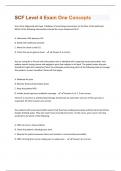Exam (elaborations)
SCF Level 4 Exam One Concepts questions and Answers Latest Update Fully Solved 100%
- Course
- Institution
Your client diagnosed with type 1 diabetes is found lying unconscious on the floor of the bathroom. Which of the following interventions should the nurse implement first? A. Administer 50% dextrose IVP. B. Notify the healthcare provider. C. Move the client to the ICU. D. Check the serum glucos...
[Show more]



